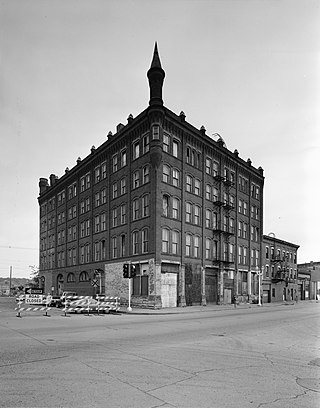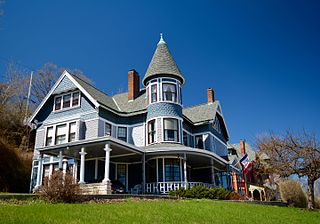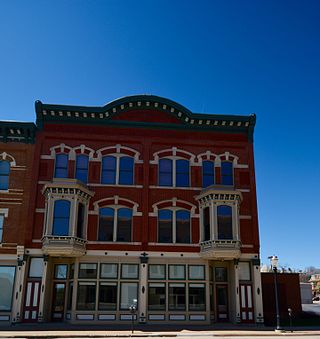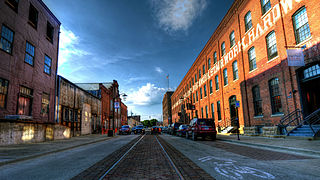
St. Luke's United Methodist Church, also known as St. Luke's Methodist and as St. Luke's United Methodist, is a historic Richardsonian Romanesque-style church located at 1199 Main Street in Dubuque, Iowa. It was individually listed on the National Register of Historic Places in 1998, and as a contributing property in the Upper Main Street Historic District in 2005. It is part of the Iowa Conference of the United Methodist Church.

The Town Clock is a large clock that stands in downtown Dubuque, Iowa. The clock has stood over the city for over 140 years. The present clock is the second "Town Clock"; the first collapsed in the 1870s, killing three people. The building on which it originally stood is listed on the National Register of Historic Places, but the clock tower itself is not.

The Langworthy House, also known as the Octagon House, is a historic building located in Dubuque, Iowa, United States. Built in 1856, it was designed by local architect John F. Rague for local politician Edward Langworthy. The two-story brick home features tall windows, a columned entry, and a windowed cupola. Langworthy and three of his brothers were among the first settlers in Dubuque. They were partners in a lead mine, helped to build the territorial road between Dubuque and Iowa City, they farmed, invested in real estate, and they owned a steamboat and a mercantile exchange. The house has been passed down through Langworthy's descendants. It was individually listed on the National Register of Historic Places in 1975, and it was included as a contributing property in the Langworthy Historic District in 2004.

The Bishop's Block, also known as the Bishop's Block Apartments, is a historic building located in Dubuque, Iowa, United States. It was individually listed on the National Register of Historic Places in 1994. It was included as a contributing property in the Old Main Street Historic District in 2015.

The Paul–Helen Building is a historic building in downtown Iowa City, Iowa. The Chicago school building was the first part of a renewal of downtown Iowa City starting in the 1910s.

State Savings Bank, also known as the Old Savings Bank, is a historic building located in Council Bluffs, Iowa, United States. the bank was established in 1889, and was originally located across the street. Planning for this building began in 1941 with the organization of the State Investment Company, which would build and own the building. It was designed by W.G. Knoebel and built by St. Louis–based Bank Building and Equipment Corporation of America. It is a late example of Art Deco, and it's the only building in Council Bluffs that exhibits this style. Two-thirds of the building is a single-story banking facility, and the rest is divided into two-stories of office space. It has one of the first drive-through teller windows in Iowa. The rectangular building's exterior is finished in gray limestone on two elevations, and a wrap-around continuation on a third. Its primary decorative feature is an inscribed harvest motif on the east and west elevations that are mirror images of each other, oriented to the north. The motif features a male nude holding a wagon wheel and a scythe, with sheaves of wheat and a dog.

The Boston Block, also known as Aalfs Manufacturing Company, is a historic building located in Sioux City, Iowa, United States. The city experienced a building boom that began in the late 1880s and continued into the early 1890s. One of the major players in that building boom was the Boston Investment Company, a company on the East Coast who built four large commercial blocks in Sioux City simultaneously. Construction on the four buildings began in 1890 and they were completed the following year. In addition to the commercial blocks, they also built a steam heating plant that provided steam and light to three of the buildings as well as to neighboring buildings. The Massachusetts Block on the southwest corner of Fourth and Jackson was six stories tall and had a similar facade as the Boston Block, which is five stories tall on the northeast corner of Fourth and Virginia. The Plymouth Block on the southeast corner of Fourth and Locust was also five stories tall, and the Bay State Block on Fourth Street is the shortest at four stories. Among the building's tenants was the Aalfs Manufacturing Company, which used the building as its headquarters.

The Charles T. Hancock House, also known as the Hancock-Gross House, is a historic building located in Dubuque, Iowa, United States. Hancock owned a large wholesale grocery firm. He hired local architect Frank D. Hyde to design this three-story frame Queen Anne. Completed in 1890, the house is situated on the brow of a 64-foot (20 m) bluff. It has views of the city below, as well as the hills of Wisconsin and Illinois across the Mississippi River. While restrained when compared with other houses in this style, it does feature an irregular plan, a wraparound porch, multiple roof lines, narrow bargeboards in the gables, and a corner tower with a conical roof. The house was individually listed on the National Register of Historic Places in 1986, and it was included as a contributing property in the West Eleventh Street Historic District in 2004.

The Garland House is a historic building located in Dubuque, Iowa, United States. Joseph C. Garland settled in Dubuque in 1889 and built a general insurance agency that grew to cover 25 counties in Iowa representing the Northwestern Mutual Life Insurance Company. He was also a community booster and philanthropist. The exterior of his large Georgian Revival home is covered with concrete block veneer, which is an unusual combination. The main facade is dominated by a two-story pedimented portico, the east elevation by a centered semicircular vault dormer, and the rear elevation by a two-story veranda. The house is capped with a hip roof with dormers. It was individually listed on the National Register of Historic Places in 1983, and it was included as a contributing property in the Langworthy Historic District in 2004.

The Ziepprecht Block is a historic building located in Dubuque, Iowa, United States. Completed in 1888, it is a fine example of transitional commercial Italianate architecture. The three-story brick structure features a heavy projecting cornice and rounded pediment from the Italianate, with larger paired windows from the Second Empire style, and three-sided bay windows from the Queen Anne style. It is also one of a small number of double storefront blocks that remain in the downtown area. The building is named for Henry Ziepprecht a German-born druggist who settled in Dubuque in 1856 and died in 1887. His estate paid to have this building constructed on the location of an older building that housed his drug store. Now managed by Joseph Wittmer, the drug store and a confectionery were the first businesses to occupy the storefronts. The upper floors housed apartments. The building was listed on the National Register of Historic Places in 2002.

German Bank is a historic building located in the Lower Main Street district of Dubuque, Iowa, United States. The city's German community was its most prominent ethnic group in the mid to late 19th century. Like many other Iowa cities of that era, Dubuque had banks that were owned by, and catered to, members of their particular immigrant communities. T.H. Thedinga, the city's first German-born mayor, started this bank in 1864 to serve immigrant Germans. In 1868 it moved from its original location on Main Street and into the former Dubuque Miners' Bank building. That building was torn down in 1901 in order to construct this one. It was designed by Dubuque architect John Spencer in partnership with Chicago architect W.G. Williamson. The three-story brick building has a highly decorative main facade composed of polished pink granite on the main floor and terra cotta on the upper two floors. Decorative elements include egg-and-dart, Greek fret, a row of small lions' heads, bay windows, scroll pediments, imperial German eagles, and a bracketed cornice with dentils. The second and third floors are dominated by four fluted, banded columns with Corinthian capitals.

The Dubuque Casket Company is a historic building located in Dubuque, Iowa, United States. The city was a leading national market in the production of caskets towards the end of the 19th century. This location had been the site of a casket manufacturing plant from 1877 to 1987. The Dubuque Furniture and Burial Case Company was the first firm in Dubuque and the first to locate here. The building was largely destroyed by fire in 1883 and the company was forced out of business. The Dubuque Casket Company was incorporated in 1893 and acquired this property. They started construction of the first part of this building the same year. The four-story brick Neoclassical building was one of the largest manufacturing facilities in Dubuque. The machine and equipment room was located on the first floor, they manufactured fine cloth covered caskets on the second floor, they manufactured undertaker's dry goods on the third floor, and the fourth floor was used for storage. The first addition, now known as the center section was begun in 1903, and another expansion that also unified the main facade was begun in 1911. Two other Dubuque casket manufacturers, Iowa Coffin Company and the Hawkeye Casket Company, were out of business by 1924.

Jackson Park Historic District is a nationally recognized historic district located in Dubuque, Iowa, United States. It was listed on the National Register of Historic Places in 1986. This is primarily a residential area, with some institutional and commercial buildings, located north of the central business district. The city originally developed just to the south of here. The Cathedral Historic District represents the oldest residential neighborhood in Dubuque, and began to house the working-class people closer to the docks. Once the Jackson Park area opened for development the city's wealthier residents built their homes here. Architectural styles rang from the vernacular, which are found mainly along the bluff, to the high style found mainly along Main and Locust Streets. Most of the houses were built from the mid to the late 19th century. The Andrew-Ryan House (1873) was individually listed on the National Register. Most of the institutional architecture are churches, which include St. John's Episcopal Church (1878) and St. Patrick's Catholic Church (1878). Central High School, no longer extant, was located across from Jackson Park, and it was also individually listed on the National Register before its demise. The Carnegie-Stout Public Library (1902) is located on the south side of the district.

Old Main Street Historic District is a nationally recognized historic district located in Dubuque, Iowa, United States. It was listed on the National Register of Historic Places in 1983. At the time of its nomination it consisted of 33 resources, which included 30 contributing buildings and three non-contributing buildings. In 2015 the boundaries were increased to include five more buildings. Four of the buildings are contributing properties that were excluded from the original district because they were slated to be torn down as a part of the expansion of U.S. Route 61. While the highway was built the buildings were spared. The fifth building is non-contributing as are three structures.

West Eleventh Street Historic District is a nationally recognized historic district located in Dubuque, Iowa, United States. It was listed on the National Register of Historic Places in 2004. At the time of its nomination it consisted of 288 resources, which included 191 contributing buildings, 32 contributing structures, 61 non-contributing buildings, two contributing sites, and one non-contributing structure. This district is a residential area on top of the bluff above the Jackson Park Historic District, which is in the river valley below. Its name comes from its historical association with the former West Eleventh Street Elevator, a funicular that was similar to the Fenelon Place Elevator to the south. For the most part the historic buildings here are single-family residences with their attendant out-buildings, although the number of out-buildings located here is relatively low. There is one apartment building and 46 duplexes. Some of the single-family houses were converted into multi-family residences, and then some of those were converted back. The various Victorian styles are found along the bluff fronts on the eastern and southern edge of the district, and vernacular structures on the northern and western sections. The Charles T. Hancock House (1890) was individually listed on the National Register. Given the steep bluffs in the district the historic structures are retaining walls and steps that replace the sidewalks.

Upper Main Street Historic District is a nationally recognized historic district located in Dubuque, Iowa, United States. It was listed on the National Register of Historic Places in 2005. At the time of its nomination it consisted of 24 resources, which included 18 contributing buildings, and six non-contributing buildings. In 2011 the boundaries of the district were expanded to include four additional buildings on the west side of the 900 block of Main Street. The district is the northern end of the city's most important commercial street. It is situated on a level terrace above the downtown area, located to the east. The buildings located on the east side of Main Street have exposed foundations along the alley because the grade descends in that direction. For the most part the district is made up of commercial buildings, although there is one house, four rowhouses, and a church. All of the buildings are masonry construction, and they are between one and four stories tall. The bell tower of St. Luke's United Methodist Church (1896) is equivalent to an eight-story building. St. Luke's Church and the Interstate Power Company Building are individually listed on the National Register.

The Dubuque Millworking Historic District is a nationally recognized historic district located in Dubuque, Iowa, United States. It was listed on the National Register of Historic Places in 2008. At the time of its nomination it consisted of 24 resources, which included 19 contributing buildings, and five contributing structures. Made up of large industrial buildings, the district represents the period of transition when Dubuque went from lumber production to millwork production. The buildings are associated with two local millworking firms, Carr, Ryder & Adams and Farley Loetscher. All of the buildings are brick construction, and are between two and five stories in height. Decorative features include pavilions, pilasters, large entry arches, decorative pediments and parapets. Two of the buildings fill an entire block, while three cover a half block. The most substantial buildings were built between 1881 and 1924.

The Upper Iowa Street Historic District is a nationally recognized historic district located in Dubuque, Iowa, United States. It was listed on the National Register of Historic Places in 2015. At the time of its nomination it consisted of nine resources, which included eight contributing buildings and one non-contributing building. The district is a single block with commercial and residential buildings on both sides of Iowa Street. It was originally a residential section on the north side of the central business district. The first two commercial buildings were substantial Italianate-style structures constructed on the north side of the block in the mid-1880s. In the 1890s larger and more elaborate Queen Anne commercial buildings were built to the south. The oldest building is an 1872 residence that was used as a doctor's office and other business purposes. It has subsequently been covered in Permastone. The rest of the buildings are brick with stone ornamentation.

The Cottage at Rock and Dubuque Streets is a historic building located in Solon, Iowa, United States. It is a good example of applying elements of the Queen Anne style to a small-scale residence. The railroad arrived in Solon in 1870, which allowed the availability of ready made millwork for its construction. It was built sometime after 1870. The 1½-story frame structure has two porches. They feature turned columns, posts, and simple turned gingerbread ornamentation. The cottage was listed on the National Register of Historic Places in 1985.

The Upper Central Avenue Historic District is a nationally recognized historic district located in Dubuque, Iowa, United States. It was listed on the National Register of Historic Places in 2012. At the time of its nomination it consisted of 65 resources, which included 56 contributing buildings, one contributing site and eight non-contributing buildings. This six block section of Central Avenue is located on the north side of the central business district. The largely linear district includes a jog at 18th Street. Below the jog the street was originally named Clay Street and above it Couler Avenue. It was also the dividing line where all commerce used the German language exclusively to the north. At one time the street featured a streetcar route and it was a significant farm-to-market route and a gateway into the city from the north.























